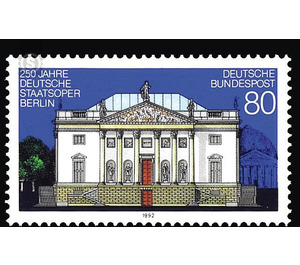250 years german state opera berlin - Germany / Federal Republic of Germany 1992 - 80 Pfennig
Theme: Architecture
| Country | Germany / Federal Republic of Germany |
| Issue Date | 1992 |
| Face Value | 80.00 |
| Color | blue |
| Perforation | K 14 |
| Printing Type | Multicolor offset printing |
| Stamp Type | Postage stamp |
| Item Type | Stamp |
| Chronological Issue Number | 1498 |
| Chronological Chapter | GER-BRD |
| SID | 594926 |
| In 35 Wishlists | |
Georg Wenzeslaus von Knobelsdorff, Prussia's most important master builder between Andreas Schlüter and Karl Friedrich Schinkel, built the linden opera as Italian court opera for King Frederick II between 1741 and 1743. The largest opera house in Europe was opened on 7 December 1742 with Carl Heinrich Graun's opera ». Cleopatra e Cesare «; However, the construction was completed only a year later. As a model Knobelsdorff served the Villa Rotonda at Vicenza of the Italian Andrea Palladio with its four portals to the four cardinal directions. Knobelsdorff also adorned his well-proportioned long-house building with four portals on all four sides. To the avenue "Unter den Linden" six Corinthian full columns carry the relief decorated gable, while the three remaining portici are marked with the same number of pilasters. Knobelsdorff united three halls under one roof: the Apollosaal, once the banquet hall, and today the place for exquisite chamber concerts and performances of chamber operas; behind it the auditorium with its three boxes of boxes; and finally the Corinthian Hall, serving as a stage for opera performances, but uniting with the auditorium in the redoubt to form a huge ballroom. Wooden winches in the basement raised the floor of the auditorium to the height of the stage. The classically clearly structured exterior and the Rococo elegance of the interiors made Berlin's Linden Opera a European architectural event. But the building did not come unchanged to the present. After the death of Frederick the Great, Carl Gotthard Langhans d. Ä., The architect of the Brandenburg Gate, commissioned the conversion of the Knobelsdorff House. To improve the view of the stage, he expanded the stage portal, concentrating the log partition walls concentrically and slanted the parquet, which for the first time received a fixed seating arrangement. In the middle rank Langhans added a royal box over two floors. Thus, the Linden Opera was from 1787 to 18 August 1843, when a devastating fire destroyed the beautiful building down to its foundations. Since Carl Ferdinand Langhans d. J. had previously developed new redesign plans, the reconstruction could begin immediately and be completed by December 7, 1844. Although Knobelsdorff's longhouse construction remained untouched externally, it was significantly altered, especially in the auditorium. A fourth rank was added, which increased the number of seats, and the interior decoration was completely changed in the neo-Renaissance style. The external structure of Knobelsdorff was lost when in 1910 a massive, inorganic concrete block was erected as a stage tower for the Schnürboden. Fire galleries and fire escapes then corrupted the facades. They were eliminated in another conversion in the years 1926 to 1928, when the house received a modern lifting, sliding and revolving stage. Already on the night of 9 to 10 April 1941, the Linden Opera went up in flames in a bombing raid. It was rebuilt as a prestige object until the 200th anniversary of the house on December 7, 1942, without any regard for the architectural specifications of Knobelsdorff or Langhans. The Apollosaal had to give way to a representative staircase in the first rank as well as various dining facilities. On February 3, 1945, this building also fell to rubble and ashes. 1951 was the decision to rebuild Berlin's Linden Opera, 1952, the laying of the cornerstone and on 6 September 1955, the festive reopening. This time, the goal of the architect Richard Paulick and his colleagues was to harmonize the architectural ideas of Knobelsdorff with the requirements of a modern opera house, a project that can be considered completely successful, because since then, the German State Opera Berlin is not only one of the most traditional, but also among the most beautiful opera houses in Europe. In the best years of its 250-year history, the Linden Opera also had the rank of world-renowned music theater. (Text: Manfred Haedler, chief dramaturge of the Deutsche Staatsoper Berlin)


